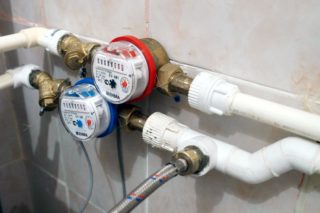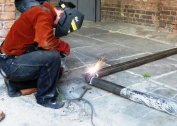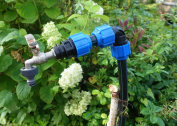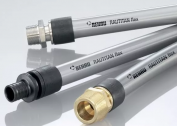Landlords are required to pay utility bills in accordance with the amount of water consumed. Counting is carried out by consumption meters, which are placed at the entrance of pipelines to the room. It is necessary to understand who is obliged to monitor serviceability, to check and replace cold and hot water meters: the consumer, the service organization, or service providers.
Why install water meters
Legislative acts do not contain a direct indication of the mandatory installation of metering devices. Moreover, it is stipulated that they are not installed in dilapidated, emergency, demolished or overhaul buildings.
The owner himself is interested in installing metering devices. Indeed, in their absence, water is charged at the rate for each person registered in the room, regardless of whether he lives there or not.
The estimated norms of water consumption per 1 person per month are:
- cold - 6.9 cubic meters m;
- hot - 4.7 cubic meters m
For rooms where the meters could be installed, but they are not there, a multiplying factor of 1.5 is used.
If there are no meters, a family of 3 people will have to pay monthly for 31 cubic meters of cold water, as well as for 21 cubic meters of hot water. This is 3-4 times higher than real water consumption.
It is more profitable to pay once for the installation of equipment than to pay large sums every month. If the meters are installed, but are being repaired or verified, the average monthly water consumption calculated on the basis of indications for the previous 6 months is accepted for charges.
For example, if a family of three from January to June spent 8 cubes of cold water and 4 cubes of hot water, then in July, having given the counters for verification, they will pay for the same amounts as before.
Purpose of checking the water meter
Meters should accurately show water flow. Inspection of equipment is carried out by competent persons in order to verify the accuracy of measurements. Based on its results, an act (conclusion) is drawn up, which decides the fate of the device.
The first check is done at the factory. This must be noted in the technical passport of the product. The recommended period for the next verification is also indicated there. In this way, the manufacturer guarantees the quality of their products or the accuracy of measurements during the calibration period.
Service life of water metering devices and their replacement
The average service life of an ordinary meter is 8-12 years, for some models 15-16 years - this is recorded in the data sheet. With proper use, metering devices can last longer.
The service life starts from the date of manufacture of the device, and not from the moment of its installation. Therefore, when purchasing a counter, be sure to be interested in the date of its manufacture indicated on the product data sheet. Take manufactured recently.
A measuring device is a complex device, the details of which wear out under the influence of external or internal factors. There may be situations when there are doubts about the correctness of the meter readings long before the end of the service life. For example, attention was drawn to the fact that the water consumption according to the meter for no apparent reason sharply increased or decreased compared to the previous month.
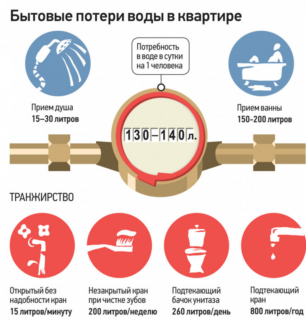 Identify the source of the problem is able to check the counter of cold or hot water at home without removing the device or turning off the water supply. Before calling the wizard, you can independently determine that the equipment began to show incorrect data due to damage to the external case or internal mechanism. This is evidenced by:
Identify the source of the problem is able to check the counter of cold or hot water at home without removing the device or turning off the water supply. Before calling the wizard, you can independently determine that the equipment began to show incorrect data due to damage to the external case or internal mechanism. This is evidenced by:
- the presence of water drops on the inner cover - depressurization of the device;
- dents or cracks;
- indicator blades do not rotate at all or jerkily.
Such violations in the work can occur under the influence of external causes:
- low water quality, the presence of sand, change readings, quickly disable;
- uneven or too strong water pressure in the pipe, which breaks the measuring mechanism;
- blockage in the pipe or in the inlet at the meter;
- water leaks that increase water consumption;
- incorrect installation, as a result of which the indicator blades rotate in the opposite direction.
Repair of the device is necessarily accompanied by verification and sealing. It is cheaper and more expedient to install a new meter with factory calibration.
Period for checking water meters
In accordance with Decree of the Government of the Russian Federation No. 354 dated 05/06/2011, the owner of the premises is responsible for maintaining metering equipment in good condition.
The time of the next verification of the meter, the consumer chooses independently as necessary.
The reason for checking the counter of cold or hot water may be their incorrect operation or the deadline for the next verification indicated in the data sheet of the device.
As a rule, domestic manufacturers set a 6-year inter-calibration interval for metering devices; independently, they are used for cold or hot water. In addition, devices appeared with a large interval between calibrations: 10-16 years.
Requirements for mandatory replacement or verification of meters are illegal. Phone calls offering services or leaflets in the mailbox that mimic an official request form are unfair advertising. Such companies, as a rule, do not even have a license for these types of work and are simply trying to lure money in any way.
Procedure for checking at home
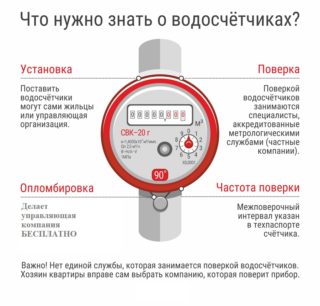 Consumers can order a check of water meters at home only in the last few years. Previously, you had to remove the device, take it for inspection, then install and seal it again. The whole procedure took several days. Now you can check the quality of the counter for several hours at home. To do this, just do the following:
Consumers can order a check of water meters at home only in the last few years. Previously, you had to remove the device, take it for inspection, then install and seal it again. The whole procedure took several days. Now you can check the quality of the counter for several hours at home. To do this, just do the following:
- Look in the data sheet for the check period.
- If the deadline has already approached or several months remain, leave an application on the website or by phone of the Center for Metrology and Standardization, or a company that is accredited to provide services for the replacement and inspection of metering devices.
- In the application indicate: address, contact phone number, name of the owner; counter parameters - model, type, manufacturer, serial number. Agree on time.
- Will be billed. It can be paid in advance and provided with a receipt to the master, or can be settled after work has been completed.
- By the arrival of the master, prepare a meter passport and a receipt for payment. Provide a free approach.
- The procedure for checking water meters is carried out without dismantling the meters. The master conducting the test connects high-precision scales to the water supply system. A fixed volume of water is driven through the meter being checked. If the meter readings coincide with the data of specialized equipment, it is considered suitable for further use.
- The master draws up an act, an agreement on the work done and puts a mark in the data sheet of the device on the verification.
- Then it is necessary to submit the act (conclusion) to the management company, housing office or homeowners association in order to establish the date of the next verification.
When the master arrives, check if he has a license to carry out work.
Legal grounds for replacing water meters
The installation of collective or individual metering devices for consumed water at the border with a centralized water supply system is regulated by Federal Law of 23.11.2009 No. 261-FZ “On Energy Saving and Improving Energy Efficiency”. Article 13 states that the replacement of metering devices should be carried out by the supplier of resources at the request of the owner of the dwelling. The cost in parts or one-time is compensated by the consumer. Maintenance, safety and replacement are carried out by the owner.
In 2019, Rosstandart plans at the legislative level to assign the responsibility for the installation, calibration and maintenance of metering devices to an organization that sells resources. The owner will only have to provide access to the meters.
